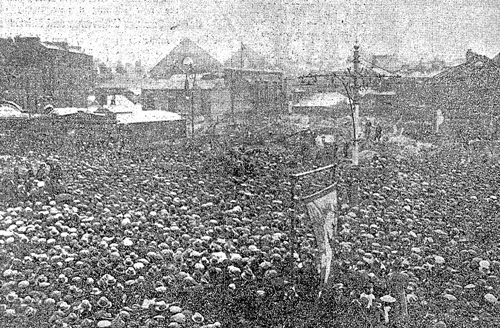Labour divisions revealed at Connolly commemoration as Larkin appeals for peace
Dublin, 14 May 1923 - Despite poor weather, an estimated 10,000 attended a demonstration yesterday in memory of executed 1916 labour leader, Mr. James Connolly.
The demonstration put a stop all traffic along the thoroughfare, including tram traffic between Nelson’s Pillar and the Parnell Monument, as members of the different branches of the ITGWU paraded with bands and banners to the agreed meeting place, where Mr. James Larkin, who had recently returned from the United States after a lengthy absence, was the principal speaker. Accompanying him were, among others, Mr. Thomas Foran, president of the ITGWU, Mr. William O’Brien TD and Mrs. Cathal O’Shannon TD.
Although it was an event of impressive scale, it also served to underline some of the tensions and divisions within the labour movement. Different sections of the crowd chose to sing different songs - the socialist anthem the ‘Red Flag’ doing battle with the Irish National Anthem ‘Soldier’s Song’ - and the various speeches were marked by interruptions, jeers and boos from the crowd.
Mr. Cathal O’Shannon TD had only got so far as to say he was a representative of the Irish Labour Party when he was greeted by a chorus of boos. Mr. Larkin, who had been given a more welcoming reception, appealed to the crowd to let Mr. O’Shannon speak and said that if their principles were such as they believed that they should not be afraid to listen to any person.
Mr. Larkin would later lament the absence of discipline among the crowd and he expressed surprise and sorrow that the widow of James Connolly would not join them on the platform.
Mrs Connolly and Miss Nellie Hynes were in attendance and had rushed through the crowds, taking up a position near a wagonette, upon which Miss Hynes climbed to exclaim to demand the release of prisoners and to ask what the Labour party was doing to secure it.
As part of Century Ireland’s series on the 1916 proclamation signatories, Prof. Fearghal McGarry profiles James Connolly
In his own address, Mr Larkin declared that he stood for a Workers’ Republic, but there was no disgrace in laying down their arms when the forces facing them were overwhelming. If James Connolly were present, he added, he would say to them ‘Have peace by understanding; reform the line and march forward to victory.’
Mr. Larkin appealed for a ‘truce of God’ for one month to allow a settlement be made. He also said that there were 15,000 of Ireland’s best men and many women in prison and that any Government that would deny their relatives access to them was not an Irish Government. He urged the Government to allow two men and two women to go into the prisons, talk to the men and women held there and come back and report -a report which they would accept.
The O’Connell Street demonstration followed days after the ITGWU held its labour day celebrations which included its annual sports meeting at Croke Park and a concert at the Theatre Royal where 3,000 attended, helping raise funds for the James Connolly Pipers’ Band.
Mr. Larkin spoke at both events. At the Theatre Royal he remarked that when deported from the USA, his deportation ticket compelled him to go to Great Britain or Southern Ireland. ‘I know no Southern Ireland’, Larkin declared. ‘I only know one Ireland - the Ireland that embraces every townland and parish within the 32 counties. I am an Ulsterman, like my dead comrade and your martyr, James Connolly.’
Mr. Larkin also urged women to take the lead on demanding peace and an end to the current hostilities.
There had been too much killing and too much talk of war and murder and no mother ever raised a boy to kill a fellow countryman, he argued. He also suggested that a Labour government would not allow the civil war to continue for one more hour as it lived for peace.
[Editor's note: This is an article from Century Ireland, a fortnightly online newspaper, written from the perspective of a journalist 100 years ago, based on news reports of the time.]





















